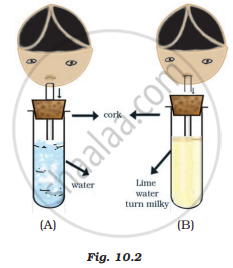Advertisements
Advertisements
प्रश्न
A student has set up "CO2 is released during respiration”. After about 1 hour he observes no change in the water level in the delivery tube. Write two possible resons for the failure of the experiment.
उत्तर
(i) The setup was not air tight
(ii) Geminating seeds were not moist
(iii) One end of U-shaped delivery tube is placed in conical flask and the other end was not immersed in the water of the beaker.
APPEARS IN
संबंधित प्रश्न
Compare the functioning of alveoli in the lungs and nephrons in the kidneys with respect to their structure and functioning.
The mountaineers carry oxygen with them because ______.
Name one substance which is produced in anaerobic respiration by an organism but not in aerobic respiration.
Name the process by which plant parts like roots, stems, and leaves get oxygen required for respiration.
Where in the lungs does gas exchange take place?
Fill in the following blank with suitable word:
The organs of respiration in man are the _____________.
Which of the following increases in muscle cells when they are lacking in oxygen?
Which of the following is the correct sequence of air passage during inhalation?
(a) nostrils → larynx → pharynx → trachea → lungs
(b) nasal passage → trachea → pharynx → larynx → alveoli
(c) larynx → nostrils → pharynx → lungs
(d) nostrils → pharynx → larynx → trachea → alevoli
Which of the following statements are true about respiration?
(i) during inhalation, ribs move inward and diaphragm is raised.
(ii) the gaseous exchange takes place in the alveoli.
(iii) haemoglobin has greater affinity for carbon dioxide than oxygen.
(iv) alveoli increase surface area of the exchange of gases
An organism X having breathing organs A lives on land. When organism X goes underwater, it cannot survive for a long time unless carrying an oxygen cylinder. On the other hand, the organism Y having breathing organs B always lives in water and if taken out of the water, it dies after a short while. A third organism Z having breathing organs C and D which lives on the banks of ponds, lakes, and rivers can survive on land as well as in water equally well.
(a) What could organism X be? Name the breathing organs A.
(b) What could organism Y be? Name the breathing organs B.
(c) What could organism Z be? Name the breathing organs C and D.
(d) Out of X, Y, and Z, which organism is (i) amphibian, (ii) aquatic, and (iii)
terrestrial?
Which chemical compound inside a cell can be termed "Currency of Energy"?
Given below is an example of certain structure and its special functional activity:
"Kidney and excretion".
Fill in the blanks on a similar pattern.
Diaphragm and _____________.
State one function of the following:
Diaphragm
State one function of the following:
Pleural fluid
Given below is an overall chemical reaction of a certain process:
C6H12O6 →LacticAcid+2ATP+Heat energy
Name the process.
Answer the following question.
How is O2 and CO2 transported in human beings?
What is common between extensive network of blood vessels around walls of alveoli and in glomerulus of nephron?
The Figure shown below represents an activity to prove the requirements for photosynthesis. During this activity, two healthy potted plants were kept in the dark for 72 hours. After 72 hours, KOH is kept in the watch glass in setup X and not in setup Y. Both these setups are air tight and have been kept in light for 6 hours. Then, Iodine Test is performed with one leaf from each of the two plants X and Y.

The function of KOH is to absorb ______.
Observe Figure 10.2 carefully and answer the following questions.

- Which process is being tested in the activity?
- What is the result of the activity? Give reasons.
